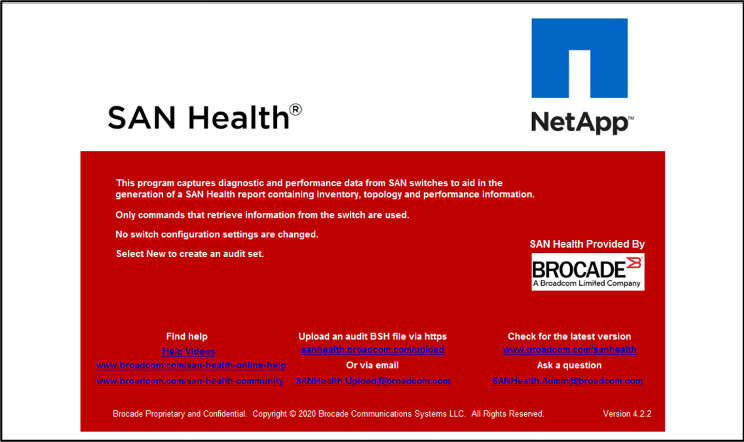Is Your SAN Healthy? Take the SAN Health Check to Find Out!


Michael Peppers
Every car needs regular maintenance checks to enable you to diagnose and fix problems early: your SAN will benefit from periodic check-ups as well. Fortunately, there’s a valuable tool that can provide a thorough health check of your entire SAN – and it’s free.
The Brocade division of Broadcom provides a SAN Health tool that provides actionable data of use to anyone who manages a SAN or consults on SAN fabrics.
In this post, I’ll cover what SAN Health is, who should use it, and what benefits they will see from adding SAN Health to their storage networking tool kit. In a future post, I’ll provide practical suggestions on how to run SAN Health, and which of the many SAN Health reports an admin or consultant should focus on first.
What is SAN Health?
Once you’ve given it permission to crawl your system, SAN Health collects configuration information and logs, analyzes that data and generates a report that gives you an accurate, in-depth inventory of devices, firmware versions, and SAN fabrics. Additionally, it captures and graphs performance data, highlights errors, and allows comparisons to best practices for configuration and zoning.SAN Health identifies components, software and operating system versions on:
- SAN switches (both Brocade and Cisco MDS switches)
- Storage products (NetApp, Dell EMC, Hitachi, HPE, IBM, etc.)
- Multiple protocols (FCP, FC-NVMe, FICON)
- Host bus adapters (HBAs Emulex, QLogic, etc.)
SAN Health Components
SAN Health has two parts: the first is the SAN health data collection tool, which is a Windows executable that you download and run against a customer SAN fabric. The tool will discover, map, diagnose, and document the components and configurations in the SAN fabric or fabrics, regardless of whether there are any Brocade components in the fabric. SAN Health will walk the fabric, discover all of the fabric components and details of the component software and firmware revisions, configurations, fan ins, fan outs, zoning, etc. Figure 1) Brocade SAN Health Data Capture Tool[/caption]
Figure 1) Brocade SAN Health Data Capture Tool[/caption]
Once the SAN Health data collection tool has finished collecting data, it compresses the data and logs into a BST file, which you can then upload or email to Brocade. Once Brocade receives the file, it is analyzed by the SAN Health application and the results are then stored and are retrievable from MyBroadcom.com. Additionally, the Brocade SAN Health application servers will send an email with the SAN Health reports to those recipients identified when data collection was initiated.
Who Should Use SAN Health
Anyone with a Fibre Channel fabric should consider running SAN Health to optimize and document their SAN infrastructure. You can use and benefit from running SAN Health regardless of whether you have any Brocade switches or Broadcom/Emulex HBAs in your fabrics. The tool creates high-quality documentation of your SAN infrastructure, and provides insights into performance, storage components, configurations, bottlenecks and even potential problems that you can proactively avoid before they impact production. SAN Health takes less than one minute to install and less than three minutes to audit your environments. Once you’ve uploaded the data, you’ll usually receive the report back within one to eight hours or so, though Broadcom’s official service level agreement is for 48-hour return.I recommend running SAN Health data collection against your fabrics at least a couple of times a year, especially right before and right after any significant changes in your fabric. Running SAN Health periodically will document and capture any changes to your fabric. Running SAN Health pre- and post-change will allow you to see what if anything has changed in your fabric aside from the activities that you are performing, such as replacing switches or hosts or upgrading storage controllers.
SAN Health Benefits
Running SAN Health eliminates whiteboard-based management. It gives you clear high-quality reporting that can be used as the basis for your SAN documentation, and even for management reporting. The report and Visio topology diagram will speed discovery and enable you to proactively fix problems like:- Performance misconfigurations
- Potential bottlenecks across fabrics, switches and ports—down to the device level
- Oversubscribed ports
- Hanging zones, or zones with too many members
- Configuration anomalies
- Unusually high port errors.
Michael Peppers
Michael Peppers is a technical marketing engineer (TME) with a focus on SAN, FlexArray/V-Series, QoS, FLI, and NVMe in ONTAP. His TME mission is to broaden and deepen the SAN, FlexArray & related knowledge of customers, partners, and coworkers, and increase the scope of NetApp's SAN & FlexArray solutions. Prior to becoming a TME Mike tested ONTAP SAN Interoperability in engineering quality assurance, before that, was an Escalations Engineer in the NetApp Technical Support Center. Before joining NetApp in 2005, Mike was a Networking and Systems administrator for several of US-based corporations.